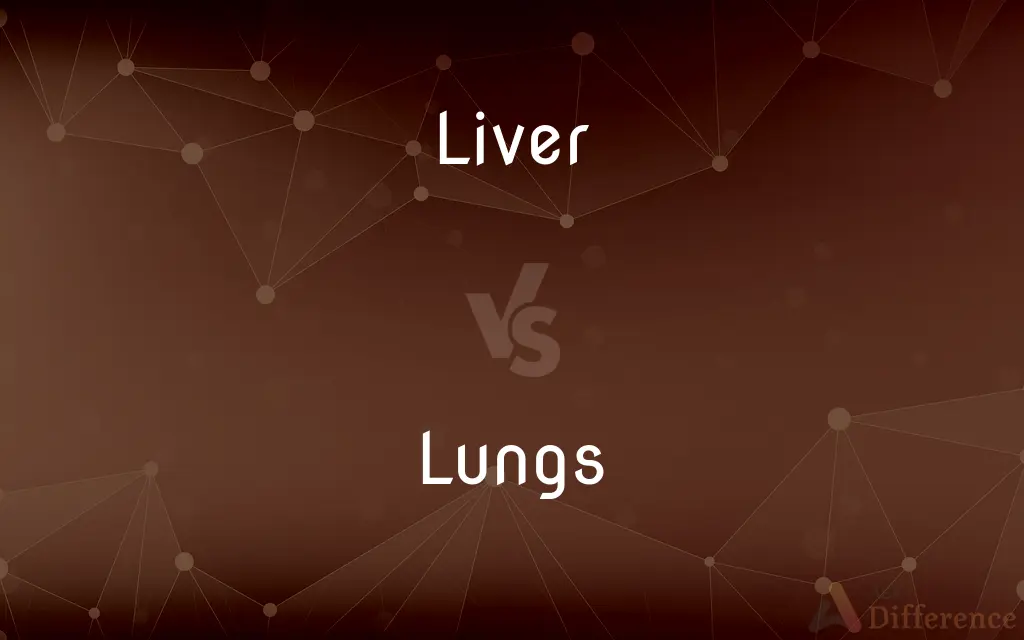Liver vs. Lungs — What's the Difference?
By Tayyaba Rehman & Urooj Arif — Published on February 7, 2024
The liver is a large, glandular organ responsible for detoxification and metabolism, while the lungs are respiratory organs involved in gas exchange, primarily oxygen and carbon dioxide.

Difference Between Liver and Lungs
Table of Contents
ADVERTISEMENT
Key Differences
The liver, a vital organ, plays a crucial role in metabolism, detoxification, and production of biochemicals necessary for digestion. In contrast, the lungs are respiratory organs primarily responsible for the exchange of oxygen and carbon dioxide, ensuring that the blood is oxygenated and free of excess carbon dioxide.
Situated in the upper right portion of the abdomen, the liver is the body's largest glandular organ and has a unique ability to regenerate. The lungs, located in the chest cavity on either side of the heart, are spongy organs protected by the ribcage and connected to the trachea through bronchial tubes.
The liver processes nutrients absorbed by the intestines, detoxifies harmful substances, produces bile for digestion, and stores vitamins and minerals. The lungs, through the process of breathing, facilitate the inhalation of oxygen into the bloodstream and the exhalation of carbon dioxide, a waste product of metabolism.
Liver diseases can range from hepatitis, cirrhosis, to liver cancer, often associated with symptoms like jaundice, abdominal pain, and swelling. Lung diseases, including pneumonia, asthma, and lung cancer, manifest through symptoms such as coughing, shortness of breath, and chest pain.
The liver plays a pivotal role in maintaining the body's metabolic balance and detoxifying blood. The lungs maintain respiratory homeostasis, ensuring that the body's oxygen and carbon dioxide levels are optimally balanced for cellular function.
ADVERTISEMENT
Comparison Chart
Primary Function
Detoxification, metabolism, bile production
Gas exchange, oxygenating blood, removing carbon dioxide
Location in the Body
Upper right abdomen
Chest cavity, surrounding the heart
Physical Structure
Large, glandular organ
Two spongy organs
Diseases
Hepatitis, cirrhosis, liver cancer
Pneumonia, asthma, lung cancer
Role in Homeostasis
Metabolic balance, blood detoxification
Respiratory balance, oxygen and carbon dioxide regulation
Compare with Definitions
Liver
Has a unique ability to regenerate and repair itself.
Even after damage, the liver can often regenerate lost tissue.
Lungs
Oxygenates the blood by transferring oxygen from inhaled air.
Oxygen from the air is transferred into the blood via the lungs.
Liver
Produces bile necessary for digestion, especially of fats.
The liver's production of bile aids in the digestion of fats.
Lungs
Expels carbon dioxide, a waste product of metabolism, from the body.
The lungs remove carbon dioxide from the bloodstream during exhalation.
Liver
Plays a key role in regulating various metabolic processes.
The liver helps regulate blood sugar levels.
Lungs
Organs involved in the exchange of oxygen and carbon dioxide.
The lungs fill with air during inhalation, facilitating gas exchange.
Liver
A large, reddish-brown, glandular organ in the abdominal cavity of vertebrates that secretes bile and is active in the formation of certain blood proteins and in the metabolism of carbohydrates, fats, and proteins.
Lungs
Situated in the chest cavity and shielded by the ribcage.
The lungs are encased by the ribcage, protecting them from physical damage.
Liver
An organ in invertebrates that is similar to the vertebrate liver.
Lungs
Play a central role in the process of breathing.
The lungs expand and contract with each breath, allowing air to flow in and out.
Liver
The bile-secreting organ of certain animals, used as food.
Lungs
Either of two spongy, saclike respiratory organs in air-breathing vertebrates, occupying the chest cavity together with the heart and functioning to provide oxygen to the blood while removing carbon dioxide.
Liver
A dark reddish brown.
Lungs
A similar organ in some invertebrates, including spiders and terrestrial snails.
Liver
One who lives in a specified manner
A high liver.
Lungs
Plural of lung
Liver
Made of or flavored with liver:liver pâté.
Liver
Of a dark reddish brown.
Liver
(anatomy) A large organ in the body that stores and metabolizes nutrients, destroys toxins and produces bile. It is responsible for thousands of biochemical reactions.
Liver
This organ, as taken from animals used as food.
I'd like some goose liver pate.
You could fry up some chicken livers for a tasty treat. — Nah, I don't like chicken liver.
Liver
A dark brown colour, tinted with red and gray, like the colour of liver.
Liver
Any of various chemical compounds—particularly sulfides—thought to resemble livers in color.
He gave his horse some liver of antimony.
Liver
Someone who lives (usually in a specified way).
Liver
Of the colour of liver (dark brown, tinted with red and gray).
Liver
One who, or that which, lives.
And try if life be worth the liver's care.
Liver
A resident; a dweller; as, a liver in Brooklyn.
Liver
One whose course of life has some marked characteristic (expressed by an adjective); as, a free liver.
Liver
A very large glandular and vascular organ in the visceral cavity of all vertebrates.
Liver
The glossy ibis (Ibis falcinellus); - said to have given its name to the city of Liverpool.
Liver
Large and complicated reddish-brown glandular organ located in the upper right portion of the abdominal cavity; secretes bile and functions in metabolism of protein and carbohydrate and fat; synthesizes substances involved in the clotting of the blood; synthesizes vitamin A; detoxifies poisonous substances and breaks down worn-out erythrocytes
Liver
Liver of an animal used as meat
Liver
A person who has a special life style;
A high liver
Liver
Someone who lives in a place;
A liver in cities
Liver
A large organ in the body responsible for detoxification and metabolism.
A healthy liver is crucial for proper metabolism.
Liver
The body's primary detoxifying organ, processing toxins and waste.
The liver filters out toxins from the blood.
Common Curiosities
Can the liver regenerate itself?
Yes, the liver has a unique capacity to regenerate and repair itself after damage.
What is the primary function of the liver?
The liver is essential for detoxification, metabolism, and bile production.
What are common diseases affecting the liver?
Common liver diseases include hepatitis, cirrhosis, and liver cancer.
How does the liver affect digestion?
The liver produces bile, which helps break down fats during digestion.
What protects the lungs in the human body?
The lungs are protected by the ribcage, which shields them from physical impacts.
What are typical lung-related health issues?
Typical lung-related issues include pneumonia, asthma, and lung cancer.
Can liver function be measured?
Yes, liver function can be measured through various blood tests and imaging techniques.
What is the significance of bile produced by the liver?
Bile is crucial for digesting and absorbing fats and fat-soluble vitamins in the small intestine.
How do the lungs facilitate breathing?
The lungs allow for the inhalation of oxygen and the exhalation of carbon dioxide, facilitating breathing.
Is the liver involved in blood detoxification?
Yes, the liver detoxifies the blood by filtering out toxins and waste products.
How does smoking affect the lungs?
Smoking damages the lungs, leading to reduced lung function and diseases like chronic bronchitis and lung cancer.
How do the lungs respond to high altitudes?
At high altitudes, the lungs work harder to oxygenate the blood due to lower oxygen levels in the air.
What is the role of the lungs in gas exchange?
The lungs are responsible for exchanging oxygen and carbon dioxide between the air and the bloodstream.
Can liver diseases be asymptomatic?
Yes, many liver diseases can progress without noticeable symptoms, especially in the early stages.
How do the lungs regulate the body's pH balance?
The lungs help regulate pH by controlling the level of carbon dioxide in the blood.
Share Your Discovery

Previous Comparison
UTRAN vs. eUTRAN
Next Comparison
Heart Rate vs. Pulse RateAuthor Spotlight
Written by
Tayyaba RehmanTayyaba Rehman is a distinguished writer, currently serving as a primary contributor to askdifference.com. As a researcher in semantics and etymology, Tayyaba's passion for the complexity of languages and their distinctions has found a perfect home on the platform. Tayyaba delves into the intricacies of language, distinguishing between commonly confused words and phrases, thereby providing clarity for readers worldwide.
Co-written by
Urooj ArifUrooj is a skilled content writer at Ask Difference, known for her exceptional ability to simplify complex topics into engaging and informative content. With a passion for research and a flair for clear, concise writing, she consistently delivers articles that resonate with our diverse audience.













































